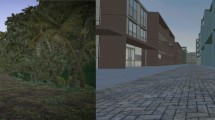Abstract
Juri Lotman distinguishes between two main types of communication. In addition to the classical I-YOU communication, he speaks about I-I communication, where both the addresser and the addressee are one and the same person. Contrary to how it sounds, autocommunication is not self-sufficient musing inside one’s self, it is remodelling oneself through a code from an entity outside oneself, be it animate or inanimate. According to Lotman, it is often the rhythmical phenomena like poetry, the rhythm of waves, etc. that lend themselves for the act of autocommunication as external codes. After having received the message one is not identical to the original oneself anymore. Perceptual markers of landscape—specific rhythms, ephemera, the rhythm of human everyday activities, bodily movement—can be considered as a secondary code leading to autocommunication in the person who contemplates the landscape. Looking at the landscape—which also implies the rhythmical movement of the eyes—one uses it as a code to reconstitute oneself. A person who has confronted a landscape does not leave it as the same person. The present article poses a definition of autocommunication in landscapes and discusses the way in which other sensorial information apart from the visual—smell, movement, rhythms etc—are used culturally to reinforce autocommunication with oneself. It can be said that several institutionalised religious and cultural practices expect the subject to reconstitute him- or herself mainly through the bodily landscape experience.










Similar content being viewed by others
Notes
Source: informal interview, recorded by the present author on April 5th, 2006.
In fact, the third of the Three Celebrated landscapes, Amano Hashidate peninsula (Kyoto prefecture), is also a coastal landscape: it is a narrow cape, stretching out into Miyazu bay, almost cutting it off from the sea. It combines the tidal rhythms with the verticality of pine forest and white stretches of sand with millions of identical sand grains. The canon of the Three Most Celebrated Landscapes (or Three Great Views of Japan, as it has also been translated) originates from the feudal Edo period (1603–1867), but all the three places have been depicted in various art forms since the earliest written history in Japan. All three locations have featured shinto shrines that date to periods from 6th to 8th century and have been popular locations for pilgrimages.
References
Bender B. (Ed.) (1993). Landscape : Politics and perspectives. Providence, R.I.; Oxford: Berg.
Broms H, & Lotman J. (1988). Greetings to the symposium. An interview with Yuri Lotman in Helsinki, June 1987. In H. Broms, & R. Kaufmann (Eds.), Semiotics of culture : Proceedings of the 25th symposium of the Tartu-Moscow school of semiotics, Imatra, Finland, 27th-29th July, 1987 (pp. 115–123). Helsinki: Arator.
Bunkše, E. (2004). Softly heaves the glassy sea: Nature’s rhythms in an era of displacement. In T. Mels (Ed.), Reanimating places: A geography of rhythms (pp. 71–86). Aldershot: Ashgate.
Bunkše, E. V. (2007). Feeling is believing, or landscape as a way of being in the world. Geografiska Annaler, Series B: Human Geography, 89(3), 219–231.
Connerton, P. (2007). How societies remember Fourteenth (14th ed.). Cambridge: Cambridge University Press.
Cosgrove, D. (2003). Landscape: Ecology and semiosis. In H. Palang & G. Fry (Eds.), Landscape interfaces: Cultural heritage in changing landscapes (pp. 15–20). Dordrecht: Kluwer Academic Publishers.
Daniels, S., & Cosgrove, D. (2007). Introduction: Iconography and landscape. In S. Daniels (Ed.), The iconography of landscape: Essays on the symbolic representation, design and use of past environments (9th printing. Original edition 1988. ed. pp. 1-10). Cambridge: Cambridge University Press
de Certeau, M. (1988). The practice of everyday life [Arts de faire.] (paperback ed.). Berkeley: University of California Press.
Farina, A. (2010). Ecology, cognition and landscape: Linking natural and social systems. Dordrecht: Springer.
Ingold, T. (2000). The perception of the environment: Essays on livelihood, dwelling and skill. London: Routledge.
Ingold, T. (2009). Against space: Place, movement, knowledge. In P. W. Kirby (Ed.), Boundless worlds: An anthropological approach to movement (pp. 29–44). New York: Berghahn Books.
Jakobson, R. (1960). Closing statement: Linguistic and poetics. In T. A. Sebeok (Ed.), Style in language (pp. 350–377). Massachusetts: MIT Press.
Kull, K. (1998). Semiotic ecology: Different natures in the semiosphere. Sign Systems Studies, 26, 344–371.
Lagopoulos, A. P. (1986). In M. Gottdiener & A. P. Lagopoulos (Eds.), The city and the sign: An introduction to urban semiotics. New York: Columbia University Press.
Lagopoulos, A. P., & Boklund-Lagopoulou, K. (1992). Meaning and geography: The social conception of the region in northern Greece. Berlin: Mouton.
Lefebvre, H. (2004). Rhythmanalysis: Space, time, and everyday life. London: Continuum.
Lindström, K., & Tønnessen, M. (2010). Being in the world of the living – semiotic perspectives. Biosemiotics, 3(2)
Lotman, Y. (1990). Universe of the mind: A semiotic theory of culture. London: Tauris.
Lotman, M. (2001). The paradoxes of semiosphere. Sun Yat-Sen Journal of Humanities, 12(April), 97–106.
Mels, T. (2004). Lineages of a geography of rhythms. In T. Mels (Ed.), Reanimating places: A geography of rhythms (pp. 3–42). Aldershot: Ashgate.
Mitchell, W. J. T. (2002). Landscape and power (2nd ed.). Chicago: University of Chicago Press.
Olwig, K. (2002). Landscape, nature, and the body politic: From Britain's renaissance to America's new world. Madison: University of Wisconsin Press.
Olwig, K., & Mitchell, D. (Eds.). (2009). Justice, power and the political landscape. London: Routledge.
Solnit, R. (2002). Wanderlust: A history of walking. London: Verso.
Widlok, T. (2008). The dilemmas of walking: A comparative view. In T. Ingold & J. L. Vergunst (Eds.), Ways of walking: Ethnography and practice on foot (pp. 51–66). Aldershot: Ashgate.
Author information
Authors and Affiliations
Corresponding author
Rights and permissions
About this article
Cite this article
Lindström, K. Autocommunication and Perceptual Markers in Landscape: Japanese Examples. Biosemiotics 3, 359–373 (2010). https://doi.org/10.1007/s12304-010-9082-0
Received:
Accepted:
Published:
Issue Date:
DOI: https://doi.org/10.1007/s12304-010-9082-0




